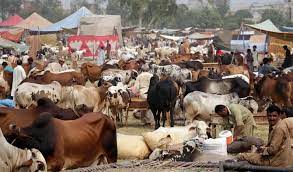F.P. Report
ISLAMABAD:– “I bought an ox for Rs120,000 and two goats for Rs112,000. Last year, the same would have cost up to Rs95,000 and Rs90,000 respectively,” said Shafique Akhtar – one of the thousands of customers – at the Shahpur Kanjran cattle market, which is the largest in Punjab, located at the Multan Road around three kilometres from Thokar Niaz Beg.
The higher prices are an obvious consequence of the inflation and the rising cost of raising animals as the sellers from the rural areas wait anxiously for an entire year to sell their cattle for profit after hard labour.
Lumpy skin resulted in huge losses for the animal farmers last year and that’s another reason why they want to recover some of the financial damage.
This story reflects the situation prevailing across the country as people are thronging the cattle markets to find a suitable goat, ox or camel.
A limited budget due to reduced purchasing power is a problem for the majority who don’t want to miss their religious duty. Thus “window shopping” is a visible practice at these markets with many customers arguing their case unsuccessfully with the sellers.
“Our income is the same but the prices are sky-high. From where would we get that much money?” buyer Ali Akbar, a 46-year-old builder, asked – says AFP in a report about the situation in the twin cities of Rawalpindi and Islamabad.
Another customer, Zerak Ali, had come to enquire about the price of a camel, which can cost up to Rs1 million.
“It is worth 700,000 for you,” Zakaria barters. But 56-year-old shopkeeper Ali leaves, leading his two grandsons towards the enclosure housing cheaper oxen.
However, there is an alternative – collective sacrifice – which is allowed in the case of large cattle like ox and camel. Thus, seven shares per ox means more people are attracted towards collective sacrifice. In the case of camel, the share count is 11.
It also means that more oxen are comparatively being sold amid the rising trend of collective sacrifice with the fewer buyers for goats as only affluent people can go for them.
The goats bought by Shafique were of 20 kilogrammes each, but there are much bigger ones too on sale in the markets not only at Shahpur Kanjran but also around the country. Reason? Ensuring that the goats are healthier makes animal farming more profitable for the farmers.
Hence, there are goats with a weight of 40 to 80 kilogrammes and a price range of Rs100,000-150,000.
On the other hand, the prices of the huge oxen on display can cross the Rs500,000 mark with some even touching Rs1 million.
But there is a problem. In case, they fail to find buyers then they would leave the market empty handed and have to sell the same to butchers – a scenario which is less lucrative but still result in profit.
Same applies to camels – the largest among the sacrificial animals. The plight of their sellers is narrated in the AFP which says hundreds of farmers have camped at livestock markets between Islamabad and Rawalpindi for two weeks, hoping to sell animals ahead of the annual holy festival starting Thursday in the country.
But with rampant inflation — reaching a record 38 per cent in May — markets are attracting smaller crowds.
According to AFP, Zakaria brought 18 camels to market after good profits last year but has sold only one so far.
“People’s purchasing power is over. Customers are not coming to the market, and those who come prefer to return empty-handed due to the high prices of the animals,” Zakaria, 21, told AFP.
It is worth noting that the meat price – be it mutton or beef [also include chicken to the list] – is already on the rise in the country.
More than 250 camels have been brought to the Islamabad market, along with thousands of bulls, cows, goats and sheep, says the AFP.
Meanwhile, the management at the cattle markets, like Lahore’s Shahpur Kanjran, is in question in many cities and towns which experienced the first rains of the monsoon season during the last few days. Mud and stagnant rainwater is causing great hardships to the customers who, in many cases, visit these markets as a family trip or picnic.
Talking about the families, noticing women and children at these markets isn’t some strange as they are more excited about the religiously-ordained yearly festival.
Eating into Zakaria’s profits are market taxes, rising fodder and truck rental prices, as well as staff wages. “I will lose millions of rupees this year,” he glumly predicts.
Bakht Zaman, a farmer from Mardan district, brought 10 camels to market and has so far sold only one for Rs500,000.
“The value of the Pakistani rupee has fallen,” says buyer Haq Nawaz. “Who will buy such expensive animals?”
Courtesy: (AFP)







